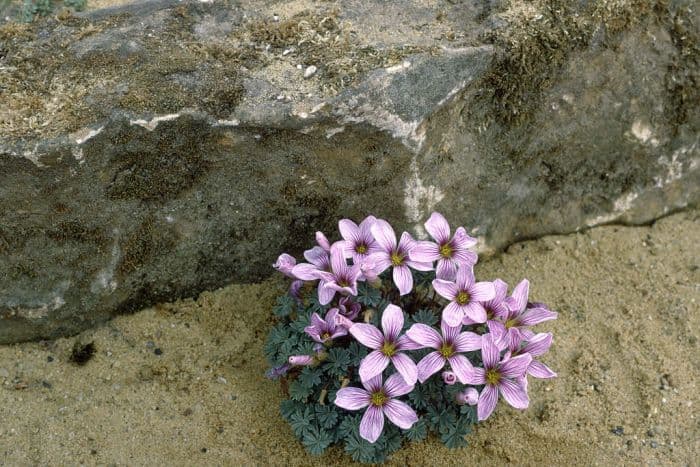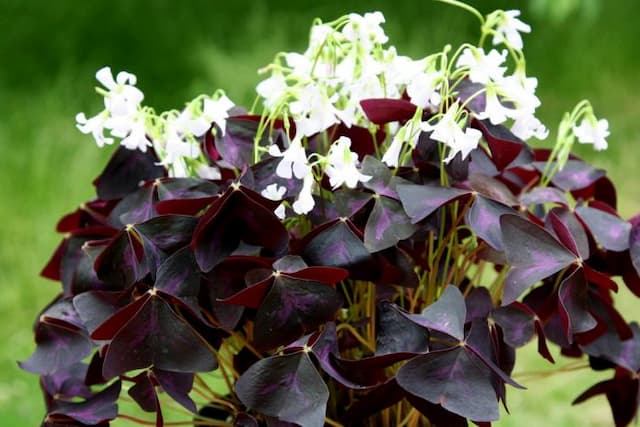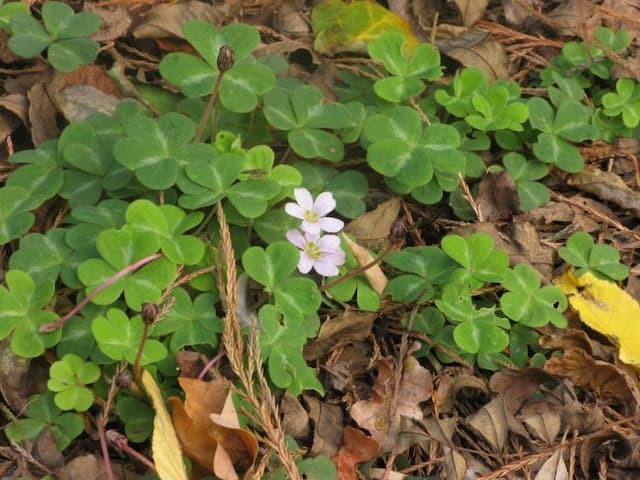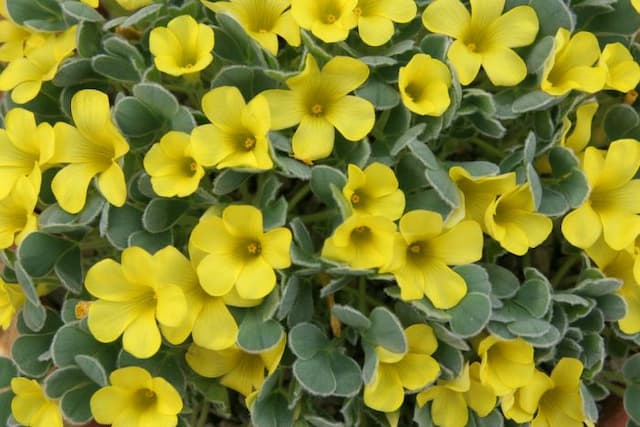Shamrock Oxalis 'Ione Hecker'

ABOUT
Oxalis 'Ione Hecker', commonly known as the shamrock plant, is a distinctive and charming perennial known for its lush, clover-like foliage. The leaves of this particular variety are typically a deep purple or maroon hue, often with a velvety texture that can catch the light, giving them a shimmering appearance. Each leaf is composed of three heart-shaped leaflets, resembling the classic shamrock form. This eye-catching foliage can add a rich contrast to any garden space or act as an attractive houseplant. During its blooming period, the Oxalis 'Ione Hecker' showcases small, trumpet-shaped flowers, which rise above the foliage on slender stems. The blossoms are often a vivid shade, contrasting with the dark leaves, and may include shades of pink, yellow, or white depending on the specific variety. The flowers attract pollinators and add a delicate touch to the plant's robust leafy display. Overall, the Oxalis 'Ione Hecker' is known for its vibrant and unique appearance, with its striking leaves and dainty flowers making it a popular choice among garden enthusiasts and indoor plant collectors alike.
About this plant
 Names
NamesSynonyms
False Shamrock, Love Plant, Purple Shamrock, Wood Sorrel
Common names
Oxalis 'Ione Hecker'.
 Toxicity
ToxicityTo humans
Oxalis 'Ione Hecker', commonly known as wood sorrel, contains oxalic acid, which is toxic when consumed in large quantities. In humans, ingestion of significant amounts may lead to symptoms such as nausea, vomiting, diarrhea, and stomach pain. Large doses of oxalic acid may also cause kidney stones or kidney failure in some cases. It is essential to avoid consuming parts of this plant, especially in large quantities, to prevent the possibility of poisoning.
To pets
Wood sorrel has a similar toxicity profile for pets as it does for humans. The presence of oxalic acid can be harmful if pets consume large amounts. Symptoms in pets may include vomiting, diarrhea, lethargy, and in severe cases, it could lead to kidney failure or other serious complications. Pet owners should prevent their animals from ingesting this plant to avoid toxicity.
 Characteristics
CharacteristicsLife cycle
Perennials
Foliage type
Deciduous
Color of leaves
Green
Flower color
Pink
Height
0.3 feet (0.1 meters)
Spread
0.5 feet (0.15 meters)
Plant type
Bulb
Hardiness zones
7
Native area
South America
Benefits
 General Benefits
General Benefits- Ornamental Appeal: The Oxalis 'Ione Hecker', commonly known as the Wood Sorrel, has vibrant, decorative foliage and flowers that add aesthetic value to gardens and landscapes.
- Low Maintenance: Wood Sorrel is a relatively easy plant to care for, requiring minimal upkeep once established in suitable conditions.
- Attracts Pollinators: The flowers of the Wood Sorrel can attract bees and other pollinating insects, benefiting the local ecosystem.
- Edible Parts: Some species of Wood Sorrel have edible leaves and flowers, though consumption should be moderate due to oxalic acid content.
- Shade Tolerant: Wood Sorrel can thrive in partial shade, making it a versatile plant for different garden areas.
 Medical Properties
Medical PropertiesThis plant is not used for medical purposes.
 Air-purifying Qualities
Air-purifying QualitiesThis plant is not specifically known for air purifying qualities.
 Other Uses
Other Uses- Oxalis 'Ione Hecker', also known as Shamrock or sorrel, can be used as a natural dye, providing shades of yellow or green depending on the mordant used.
- The plant can serve as a pH indicator, as its juices turn pinkish-red in basic solutions thanks to its anthocyanin content.
- Leaf imprints from the Oxalis can be used in arts and crafts for creating intricate botanical designs on paper or fabric.
- The leaves and flowers can be crystallized with egg whites and sugar for decorative garnishes on desserts.
- In a vegetable garden, Oxalis can act as a trap crop, attracting pests away from more valuable plants.
- Oxalis can be grown in small pots as living, decorative accents for place settings at eco-friendly or garden-themed events.
- Use the folded leaves for subtle, nature-inspired origami projects, taking advantage of their natural creases.
- The long, slim stems can be woven to create miniature wreaths or jewelry, embracing its natural flexibility when fresh.
- The blossoms add an ornamental touch to salads and summer drinks, offering a mild tangy flavor and vibrant color.
- Pressed Oxalis leaves can be embedded into handmade soaps or candles for a botanical aesthetic and texture.
Interesting Facts
 Feng Shui
Feng ShuiThe Oxalis plant is not used in Feng Shui practice.
 Zodiac Sign Compitability
Zodiac Sign CompitabilityThe Oxalis plant is not used in astrology practice.
 Plant Symbolism
Plant Symbolism- Good Fortune: Oxalis is commonly known as shamrock or wood sorrel and is often associated with luck due to its resemblance to the four-leaf clover.
- Happiness: The plant's bright and cheerful appearance symbolizes joy and a light-hearted spirit.
- Resilience: The oxalis plant's ability to bounce back after disturbance is seen as a sign of resilience and the ability to recover from challenges.
 Water
WaterThe Shamrock plant prefers evenly moist soil, so water it when the top inch of soil feels dry to the touch. Typically, this may equate to watering about once a week, but this can vary based on environmental conditions. Use lukewarm water and gently water the soil until you see water just start to come out of the drainage holes, which might take approximately 8-16 ounces depending on pot size and soil dryness. Reduce watering during the dormant period in winter and ensure that the plant is not left in standing water to prevent root rot.
 Light
LightShamrock plants thrive in bright, indirect sunlight. A spot near a north or east-facing window where it can receive plenty of ambient light without being exposed to the harsh afternoon sun is ideal. Avoid prolonged exposure to direct sunlight, as it can scorch the delicate leaves of the plant.
 Temperature
TemperatureShamrock plants prefer temperatures between 60-75 degrees Fahrenheit. They can survive a range down to about 50 degrees Fahrenheit, but they should not be subjected to temperatures below this, as cold conditions can damage the plant. On the upper end, they should be protected from temperatures exceeding 80 degrees Fahrenheit to prevent heat stress.
 Pruning
PruningPruning Shamrock plants is usually done to remove dead or yellowing leaves to encourage healthy growth and maintain a pleasing appearance. It is best to prune the plant in the spring as it begins to grow more actively. Simply snip off the unwanted foliage at the base using clean scissors or pruning shears. Pruning can be done as needed throughout the growing season whenever you notice fading or damaged leaves.
 Cleaning
CleaningAs needed
 Soil
SoilThe best soil mix for Shamrock (Oxalis 'Ione Hecker') is a well-draining potting mix composed of peat, perlite, and sand in equal parts. The soil pH should be slightly acidic to neutral, ranging from 6.0 to 7.0.
 Repotting
RepottingShamrock plants like Oxalis 'Ione Hecker' should be repotted every 2-3 years or when they outgrow their current container.
 Humidity & Misting
Humidity & MistingShamrock plants, including Oxalis 'Ione Hecker', thrive best at moderate humidity levels, between 40-50%.
 Suitable locations
Suitable locationsIndoor
Use well-draining soil, bright indirect light, and water when dry.
Outdoor
Place in partial shade, protect from hot sun, and ensure well-draining soil.
Hardiness zone
7-10 USDA
 Life cycle
Life cycleThe Oxalis 'Ione Hecker', commonly known as the Shamrock Plant, begins its life cycle as a bulb or rhizome, which upon exposure to favorable conditions of moisture and temperature, germinates and puts out shoots. These shoots develop into leaves that form the distinctive clover-like foliage, which may be green or purple, depending on the variety. In the vegetative stage, the plant grows and matures, photosynthesizing to build reserves. The Shamrock Plant eventually blooms, producing small, often white or pink, flowers that can lead to seed production if pollinated. After flowering, the plant often enters a period of dormancy, particularly in climates with a distinct winter, during which the above-ground foliage may die back. The cycle is completed when the plant re-emerges from dormancy in the next growing season, resuming growth from the bulb or rhizome.
 Propogation
PropogationPropogation time
Spring-Early Summer
Propogation: Oxalis 'Ione Hecker', commonly known as the Shamrock plant, is generally propagated by dividing the bulb-like structures called rhizomes or corms. The ideal time for this is in the late winter or early spring before new growth begins. To propagate, unpot the plant and gently separate the corms, making sure that each division has at least one growth point. These corms can then be planted in a well-draining soil mix at a depth of about 1 inch (2.54 cm) with the pointed end facing up. Water the newly potted corms lightly to settle the soil around them. New shoots should appear in several weeks, and the plants will gradually establish a new root system. This method is simple and ensures genetic consistency in the offspring.




